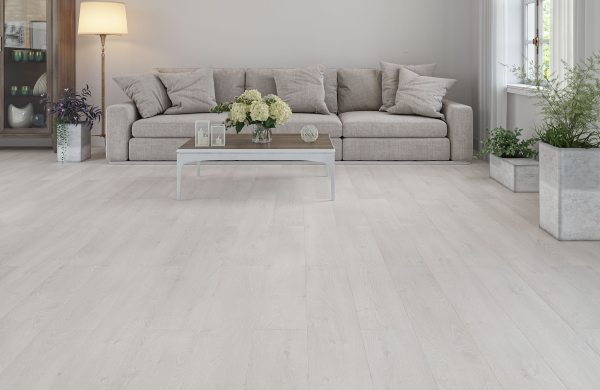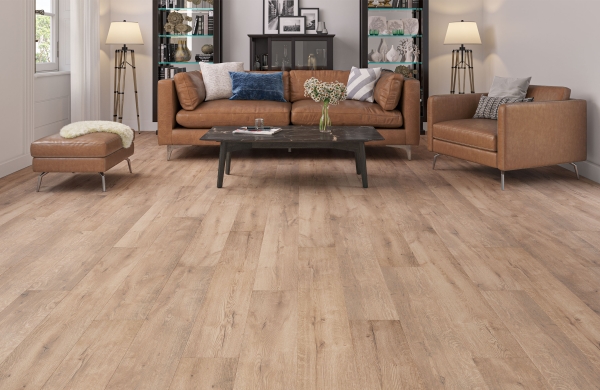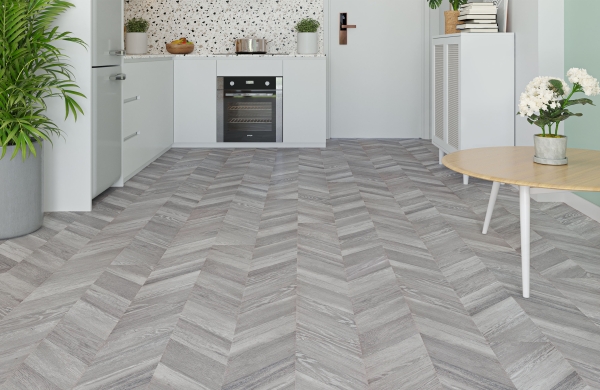Which is better – laminate or LVT flooring?
While laminate and LVT look similar, they each offer their own unique benefits.
Laminate is water-resistant, making it ideal for kitchens, dining rooms and living spaces. It’s also a breeze to clean, needing just a daily sweep and weekly mop to keep it looking its best!
Laminate is designed with durability in mind and doesn’t scratch easily, making it a great choice if you have kids or pets. It’s easy to fit thanks to its handy click-fit system and is compatible with underfloor heating.
LVT (Luxury Vinyl Tile) is waterproof, so it offers the best protection for areas prone to large spills, such as your bathroom or wet room.
Like laminate, LVT is extremely durable and resistant to scratches. It boasts the same click-fit installation as laminate and pairs perfectly with underfloor heating.
The major difference between laminate and LVT is their tolerance for water. Which is better for you will depend on whether you need a waterproof floor or a water-resistant one.
Which laminate flooring is best?
Our laminate flooring is available in a range of thicknesses, from 8mm to 12mm.
Which is best for you will depend on your personal preferences and budget. For example, you might prefer a floor that replicates the thickness of real wood, like our 12mm laminates or you might want a more affordable option like one of our 8mm styles.
How much does it cost to lay laminate flooring?
The cost of installing laminate flooring depends on several factors, such as the size of the room, the style and thickness of the floor and any work needed to prepare the subfloor for installation. The area where you live is also likely to be a factor in the cost.
Most professional fitters will charge by the day or provide a total price for completing the installation. According to Checkatrade , the average daily rate for installing laminate is £270 or £30 per hour.
How thick is laminate flooring?
Our laminate flooring comes in several thicknesses, allowing you to choose whichever suits you best.
The thinnest laminate floors we have are 8mm thick. These are a great choice if your room has a low ceiling and you want to maximise the space you have. Our 8mm laminates are also our most affordable option, making them perfect if you have a smaller budget.
The next level up in thickness is our 10mm laminate range, followed by our 12mm range. These offer a thickness closer to real wood.
How long does laminate flooring last?
On average, laminate flooring will last around 15-25 years, depending on its quality.
Our laminate flooring is designed to last for the maximum length of time. It even comes with a 25-year warranty for your peace of mind.
What’s the best underlay for laminate flooring?
There are several underlay options for laminate flooring but the one that’s best for you will depend on your subfloor and whether you’re also installing underfloor heating.
Find out more about which underlay to choose in our blog, The Best Underlay for Wood and Laminate Flooring.
How do I work out how much laminate flooring I need?
You can work out how much laminate flooring you need by taking some measurements of your room.
Start by measuring the width of the room and then measure its length.
Use a calculator to multiply the width by the length and you’ll have the number of square metres of flooring you’ll need. Just make sure you add an extra 10% for wastage so you don’t run out of planks!
For more details, check out our blog, How to Measure for Laminate Flooring.
How do I edge my laminate flooring?
Finishing the edges of your laminate flooring will help cover any expansion gaps and create a seamless finish.
We have a collection of beading and thresholds available, with colours to match each of our laminate floors.
The accessories you’ll need to finish the edge of your floor will depend on what needs to be covered. For expansion gaps between the floor and the wall, beading or skirting will do the job. For expansion gaps in doorways, a T-profile will be best. However, if there’s a difference in height from one room to the next, you’ll need a ramp profile or semi-ramp profile instead to create a smooth transition.
If you’re unsure about what’s best for your floor, chat to our flooring experts – they're always happy to help!
What’s the best way to clean a laminate floor?
Laminate is one of the most low-maintenance floors on the market but there are still a few things you’ll need to do to keep it looking its best.
A daily sweep or vacuum will prevent build-up of dust and dirt. Use a soft broom or vacuum attachment as hard bristles may scratch the surface of your laminate floor.
We also recommend a weekly mop to remove any stubborn marks and keep your floor gleaming. For this, you’ll need a slightly damp microfibre mop. Make sure the mop isn’t sopping wet, as excess water may damage your floor.
Read our blog post, How to Maintain Your Laminate Flooring for more tips on keeping your floor in tip-top shape.



































